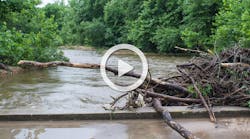Hydroseeding: Bridging Effectiveness & Quickness
Adam Dibble is director of marketing for Profile Products. Dibble can be reached at [email protected]. Daniel Reynaga is western regional sales manager for Profile Products. Reynaga can be reached at [email protected].
undefinedCommuters loathe it. The construction projects that seem to drag on long after they thought it would be over. Contractors dread it. The moment when it starts to look like a project might take longer than anticipated. Not only does going over schedule on projects erode public trust, it can also carry a heavy price tag.
According to a 2019 survey from Autodesk & Dodge Data, 66% of general contractors are carrying added costs from overtime/second shifts on at least 75% of their projects due to schedule slippage, with 50% of them needing to extend the project end date. Respondents agreed, keeping a project on schedule is paramount to success.
That is exactly what joint venture Flatiron-Skanska-Stacy and Witbeck (FSSW) and Pacific Restoration Group Inc. (PRG) sought to do on a recent San Diego Rail Corridor project. Once construction of the railway was completed, the site needed to be revegetated to receive a Notice of Termination (NOT). To keep the project on schedule, the contractors chose to hydroseed the area with ProGanics Biotic Soil Media, a soil amendment that accelerates the development of depleted soils and substrates with low organic matter, nutrient levels and biological activity.
This solution not only led to a quick notice of termination (NOT), it helped keep the project on schedule and finished without any delays.
Finding A Quick & Effective Solution
The San Diego Railway Corridor is the second busiest intercity passenger rail line in the U.S. and serves as a vital link for passenger and freight movement in the region. To meet new demand, a portion of the 351-mile Los Angeles-San Diego-San Luis Obispo coastal rail corridor needed an upgrade. The project added 1.5 miles of second mainline rail track to the corridor and replaced a more than 70-year-old timber rail bridge with a modern, double-track concrete bridge.
However, delays in the construction phase led to a portion of the project falling behind by months. While workers were able to work long days to bring the project closer to being on track, the revegetation portion of the project was at risk of falling outside of the ideal window for rainfall in Southern California. That created pressure on PRG to develop a solution for revegetation that could be employed quickly and also be effective on the first try.
The original specifications for the project called for installing compost and incorporating on the newly renovated slopes. While trucking in compost or topsoil can be a viable solution on specific projects, often the quality of compost varies between batches, and it may not have the optimal pH, nutrient levels or organic matter to effectively grow vegetation.
The site also had strict safety protocols that needed to be followed around the railways. Trains were still operating and worker safety was of the utmost importance. Compost installations can require dozens of truckloads of material to access the site along with a large team of workers, which could have been difficult around the railways.
“When we saw that the specification was for compost, we were aghast at that,” said Chip Picheloup with FSSW, one of the general contracting firms hired for the project. “We worked closely with PRG, and we didn’t know if we had the guys to support that.”
PRG was also concerned that employing compost was not the optimal solution to quickly and safely achieve the NOT. Instead, they worked with Profile Products’ western regional sales manager Daniel Reynaga, CPESC, QSD, to propose a new solution that would not only effectively amend the soil for optimal growth conditions but was also quick to employ and simple enough to work well with the safety protocols in place. Ultimately, they chose a hydraulically applied solution that emphasized the importance of soil amendments.
Hydroseeding With Confidence
The first step was to take a soil test to determine what amendments, if any, were needed to ensure optimal soil conditions. Soil testing is crucial to the success of revegetation projects because without a healthy foundation of hospitable soil, the chances of establishing and sustaining vegetation are dramatically reduced.
The test showed there was less than 1% organic matter, which is insufficient to establish vegetation, and an amendment would be necessary. PRG chose to employ ProGanics Biotic Soil Media to provide the organic matter and biological constituents to sustainably establish the vegetation the site needed. Because biotic soil technologies are manufactured, they are consistent from batch-to-batch and are proven to increase vegetation efficacy on the first application.
The soil media is hydraulically applied with a hydroseeder, meaning it cuts down on the number of workers and vehicles that need to be on the site. On one acre of land, the installation only requires two hydroseeder tanks and 5,000 pounds of product. That same acre requires 36 truckloads of topsoil to achieve similar results.
“The fact that it could be hydraulically applied was the kicker for this,” Picheloup said. “Instead of having guys with rototillers with access that you need to coordinate with the railroad to do anything on, we were able to rip the slopes with a dozer, track walk them, and apply the ProGanics.”
Using a hydroseeder, PRG applied the soil media at 5,000 pounds per acre in early February 2019. The contractor also chose to employ a native coastal seed mix that was ideal for the arid climate. To hold everything in place on the slope, PRG also hydraulically applied Profile Wood with a tackifier at 2,500 pounds per acre. This entire solution was applied in approximately half the estimated time it would have taken to install compost.
The Results
In order to receive the NOT, the project site needed to have 70% vegetative coverage. A few days after application, the site encountered a major rainstorm. The mulch did its job and held the soil and seed in place, and the initial rainfall encouraged growth.
That timing proved to be crucial. Within a few months, and far quicker than expected, the site earned the NOT. Typically, on similar sites that have no irrigation, growth can take two to three years with a native seed mix. On this site, the contractor achieved substantial growth within a third of the time.
Nearly two years later, the site is thriving with substantial growth and no reported issues. The combination of biotic soil technology with native seed proved to be a viable solution that kept the project on schedule.


